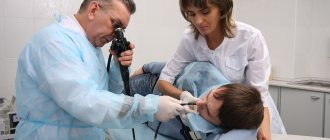- December 4, 2019
- Gastroenterology
- Legina Marina
The digestive system is one of the most complex in the human body. Various organs are involved in grinding food, pre-processing it, dissolving it into nutrients, and disposing of waste. Each of them plays its role in this chain, and thanks to this the process goes smoothly. But the more complex the system, the easier it is to introduce discord into its activities and the more difficult it is to find the causes. Pain in the rectum, for example, can be a signal of dozens of different problems. Let's try today to make a brief overview of the possible culprits of this symptom.
Briefly about the main thing
The rectum is the final section of the digestive system, which ends at the excretory opening. In fact, nothing happens here anymore. What your body cannot absorb is formed into a lump and comes out; this is the main task of this section of the intestine.
But do not underestimate its importance, as well as the severity of the work performed. Poor nutrition and stress greatly harm the body. Constipation occurs, often causing colitis. The food lump itself, especially if it is dry and compressed, can injure the intestinal walls. Let’s not forget about the stress we put on it during constipation. As a result, one small problem grows into dozens of others. But among all this you need to find the reason.
Rectal pain is a symptom that causes inconvenience and suffering. But most patients do not go to the doctor, believing that they will find a solution themselves, or are simply embarrassed to talk about such a delicate problem. But we must remember that pain does not appear by itself. It is the watchdog of human health. And the stronger it is, the more persistently it declares the need for treatment. But most ailments of the intestines and anus really need timely treatment.
Main causes and treatment of discomfort
Defecation - the removal of feces from the body through the rectum occurs regularly in humans. The main volume of “waste” is contained in the final sections of the large intestine. The rectum is the most sensitive, because it contains the most nerve endings, so pain after bowel movements occurs there, but what is their cause?
The appearance of discomfort after bowel movement can be caused by:
- flatulence;
- paraproctitis;
- cracks in the rectum;
- haemorrhoids;
- peptic ulcer;
- prostate problems in men;
- diseases of the pelvic organs in women.
Can it occur in a healthy person?
Most often, when we turn to family or friends for advice, they give the following verdict: “You’re healthy, you just ate something, you were nervous (etc.).” That is, the causes of pain in the rectum come down to banal food poisoning. This is actually not true. There are only two options when pain in the anus is not associated with any pathologies:
- In some people, it occurs after sitting on a hard chair for a long time every day. Typical for office workers.
- Muscle spasm, which is located near the anus. But this situation is typical for the most part only for teenagers (the older the person, the lower the probability). In addition, any antispasmodic will solve the problem.
Description of the disease
Worrying symptoms
Pain in the rectum has causes associated with oncology. This symptom occurs due to the growth of intestinal tumors to neighboring tissues, destroying the muscles. In this case, urination is disrupted, the menstrual cycle is disrupted, and cystitis breaks out.
Pain in the posterior canal is noted in the presence of cracks. Symptoms intensify: pain in the anus with prolonged sitting, during bowel movements. Pulsation with shooting in the anus is felt in the morning and at night. The feces come out with blood.
With paraproctitis, the lower abdomen hurts and radiates to the anus. The painful syndrome is long-lasting, twitching, accompanied by swelling of the external canals, redness, and elevated temperature. Soreness of the anal canal is observed with hemorrhoidal pathology of the 2-3-4 stages of development. Acute hemorrhoids are noted with painful lumps and painful bowel movements. When you have a bowel movement, your lower abdomen also hurts.
With ulcerative pathology, bursting, sharp colic is observed, the process of defecation is disrupted, and traces of blood are observed in the feces. When the prostate is inflamed, a pain is felt in the rectum, and the outflow of urine is disrupted.
In women, abdominal pain may radiate to the rectum during ovulation. These symptoms may be caused by:
- adnexal cyst;
- inflammation of the urinary system;
- endometriosis.
Severe colic is observed during menstrual periods, accompanied by lumbar pain. Pregnant women also face unpleasant symptoms of pain due to constipation and fetal motor activity.
Types of pain
To better understand what we are dealing with, the doctor must collect the maximum amount of information, because he needs to find the true cause. Pain in the rectum can be different, so try to tell the specialist about your sensations as fully as possible.
First of all, pain is divided into acute and chronic:
- Acute appears suddenly and can be very strong. But the sensations pass just as quickly.
- Chronic pain is less pronounced, but bothers the patient for a long time.
In addition, the nature of the sensations can be stabbing, cutting, pulling and aching. This makes it possible to draw preliminary conclusions as to why the discomfort arose and what its causes were. Pain in the rectum can indicate a variety of diseases, and such clarification will make it possible to make a preliminary diagnosis even before conducting an instrumental examination.
Why is it dangerous to ignore a symptom?
Pain in the rectal area cannot be ignored. If the symptom is constant or occurs periodically, it is necessary to evaluate its nature, the conditions of its occurrence, and note other changes in well-being. It is the exact information provided by the patient during a visit to the clinic that helps to preliminarily determine a possible disease causing pain in the rectum and prescribe the necessary diagnostic procedures to confirm it.
If the rectum hurts and a person does not seek medical help, there is a high probability of a significant deterioration in health. In some cases, the symptom indicates fatal pathologies.
Interesting11Not interesting0
Why does acute pain develop?
Sometimes people complain that its intensity is very high, the face turns pale and sweat appears on the forehead. Acute pain may be a symptom of an anal fissure. Unpleasant sensations are localized precisely in the anus. This indicates that a defect has formed in the mucous membranes of the intestine. This is facilitated by the passage of hard feces through it, frequent constipation or, conversely, prolonged diarrhea, and injury from foreign bodies.
With cracks, severe and severe pain occurs during bowel movements. The rectal mucosa is rich in nerve endings. Therefore, the pain also spreads to the sacrum, perineum and other pelvic organs. In this case, problems with urination or menstruation are noted, if we talk about women.
If you have recently developed pain in the rectum after defecation, consult a doctor. It won't take him long to get the correct diagnosis. Most often, the pathology is treated with various creams, ointments or suppositories.
Anal fissure
A small defect, a disruption in the mucous membrane in the form of a gap in the outer part of the anal canal is called an anal fissure. Its occurrence is associated with unfavorable factors - mechanical damage to this area, its infectious lesions or neuro-reflex causes. Physical stress, childbirth, a tendency to constipation or diarrhea often provoke pathology.
© shutterstock
If there is an anal fissure, the patient may note the main signs:
- pain in the anus, rectum;
- the appearance of bleeding from the anus;
- sensation of cutting, itching, burning in the anal area;
- sharp pain in the rectum during and after defecation;
- spasm of the anal sphincter.
Patient complaints, medical examination of the perianal area, and palpation of the rectum can help identify an anal fissure. A differential diagnosis of the disease is carried out. Depending on the person’s condition and the degree of development of the pathology, treatment is prescribed to get rid of fissures and pain in the rectum. Complex methods are used - drug treatment, physiotherapy, surgery, a special diet, and regular hygiene procedures.
Haemorrhoids
This is one of the main causes of pain in the rectum. People often confuse a fissure and hemorrhoids. In fact, their nature is completely different. This pathology is associated with an increase in size and thrombosis of hemorrhoidal veins, which are located in large numbers around the rectum and anus.
It should be noted that pain with this disease does not appear immediately. The patient has been bothered by itching or burning for a long time. If you don't pay attention or don't take action, pain may also follow. At the same time, drops of blood can be seen during bowel movements, and in the later stages the patient can detect prolapsed nodes and reset them independently.
As you can see, it is difficult to make a diagnosis based on symptoms. It is also necessary to determine the nature of the pain in the anus. There may be many reasons, but there is only one effective treatment strategy. Usually, if a person suffers from hemorrhoids, he is very familiar with its symptoms. But at one “wonderful” moment the pain can become shooting, throbbing, and very strong. This is one of the options for exacerbation of hemorrhoids, when blood clots form inside each node and blood flow is disrupted. In this case, the patient feels distension, as if there is a foreign body in his rectum.
Another complication can be considered strangulation of the hemorrhoidal node. It falls out and is injured in the anal ring. As a result, the patient suffers from severe pain. Treatment must be comprehensive. Usually a drug is prescribed to improve the patency of the veins, this can be Phlebodia or analogues. Additionally, therapy is carried out using local agents.
Proctalgia
Sharp, paroxysmal pain in the rectum and anus, which can radiate to the tailbone, perineum, pelvis, or felt in the abdomen, may be a sign of proctalgia. Soreness provokes muscle spasm. Neurological causes, significant physical or emotional stress, diseases of the intestines and organs located in the pelvis contribute to the development of proctalgia.
© shutterstock
The disease is usually long-term, accompanied by periods of exacerbation and calm. Pain in the rectum often occurs at night, attacks are observed during the daytime and have an increasing character. Pain in the intestines is not associated with the process of bowel movement.
The doctor conducts a physical examination of the anal area, which hurts, and palpation of the anal canal . Instrumental diagnostics of proctalgia is used - retromanoscopy, colonoscopy, irrigoscopy, ultrasound. Consultation with a gynecologist or urologist is necessary.
To get rid of pain in the rectum during proctalgia, procedures are used - novocaine blockades, microenemas with anesthetic solutions, physiotherapy (diathermy, mud therapy, UHF, laser therapy), therapeutic massage, switching to proper nutrition. Sedative drugs are prescribed.
Acute proctitis
This is an inflammatory process that occurs in the mucous membrane. It manifests itself as pain in the lower abdomen and rectum. It can be piercing or cutting, shooting. It is often accompanied by general malaise and increased body temperature. When the inflammatory process is started, the patient may see blood and pus during bowel movements. In the absence of therapy, the disease becomes chronic and constantly bothers the person with unpleasant sensations.
Develops as a concomitant pathology. As you know, the intestines are surrounded by adipose tissue. She is highly susceptible to pathological processes. Purulent inflammation of the peri-rectal tissue is called paraproctitis. These pathologies are developing very rapidly. The person feels severe pain, weakness, and his temperature rises. And this is not to mention the fact that during defecation he is ready to scream.
This disease is treated with antibiotics. The main thing is to choose the right course that will directly affect the pathogen. Be sure to use painkillers, usually suppositories with an anesthetic. Sometimes surgery is necessary. If left untreated, the disease becomes protracted. In this case, the patient is faced with the formation of purulent fistulas.
Causes of pain during bowel movements
Pain during bowel movements may be the only symptom of pathology or accompanied by other signs:
- the appearance of mucus or blood in the stool;
- itching and burning in the rectum and around the anus;
- lower abdominal pain;
- constipation;
- flatulence;
- bloating.
These symptoms indicate intestinal pathology. If even one sign from the list appears in combination with pain, you should consult a doctor.
Pain without blood
Characteristic for the following conditions:
- Sphincteritis. Inflammation of the anal canal structures is rarely an isolated disease. The pathology occurs against the background of pancreatitis, peptic ulcer, and long-term enterocolitis. The cause may be taking antibiotics, a previous intestinal infection, dysbacteriosis and other conditions. The inflammatory process occurs with the appearance of itching, burning, and discomfort in the rectum. Unpleasant sensations intensify during bowel movements, especially if there are stool problems (diarrhea or constipation). Symptoms disappear after treatment of the underlying disease.
- Cryptit. Inflammation of the rectal sinuses occurs due to injury to the mucous membrane from solid feces or intestinal irritation as a result of diarrhea. The pain can be of varying intensity - from mild to severe with sharp shooting and irradiation to the lower back. There is a feeling of a foreign body in the rectum, burning, severe itching. The appearance of abundant purulent or mucous discharge is characteristic.
- Colitis. Inflammation of the large intestine with the development of constipation leads to pain during bowel movements. Discomfort is associated with the passage of hard stool through the anal canal.
- Acute paraproctitis. Inflammation of the peri-rectal tissue is accompanied by severe pain during defecation, tissue swelling, and discharge of pus from the anus. An increase in body temperature is typical. Urgent doctor's help is required!
- Fistula of the rectum. A natural result of the development of paraproctitis. The fistula itself does not hurt, but when it becomes inflamed, there is discomfort during bowel movements. The appearance of purulent discharge is characteristic.
- Coccygeal move. It is formed during intrauterine development and is an anomaly of the intestinal structure. May remain asymptomatic for many years. Pain occurs when the epithelial coccygeal duct becomes inflamed.
- Anal canal stenosis. Narrowing of the lumen occurs against the background of inflammation, after injury, or surgery. May be a congenital pathology (detected in the first year of life). Pain is observed during bowel movements and worsens in case of constipation.
- Neurological pathology. Pain during defecation may be one of the manifestations of osteochondrosis affecting the lumbar and sacrococcygeal area.
Be sure to read: What is anoscopy and how is it performed?
In women, several conditions should be identified that lead to pain during bowel movements:
- Injuries during childbirth. Muscle tension and damage to the mucous membranes of the perineum leads to pain when visiting the toilet. Symptoms persist for up to two weeks and subside after tissue healing.
- External endometriosis. Damage to the tissues around the intestines leads to characteristic pain. Unpleasant sensations intensify a few days before menstruation, persist during menstruation and 1-2 days after them.
- Uterine fibroids. The tumor, located in the subserous layer next to the intestines, puts pressure on it, leading to constipation and pain during bowel movements.
A diagnosis can be made after a complete examination by a gynecologist.
In men, pain during bowel movements may be associated with prostatitis, an inflammation of the prostate gland. In the acute stage of the disease, discomfort is accompanied by an increase in body temperature. As the process becomes chronic, discomfort decreases, and minor pain is noted only during exacerbation. Diagnosis and treatment are carried out by a urologist.
Pain with blood
The appearance of pain during defecation against the background of bloody discharge from the anus occurs in the following conditions:
- Haemorrhoids. Uncomplicated hemorrhoids do not hurt. Discomfort occurs with thrombosis or prolapse of nodes. The pain can be of varying severity. Blood may appear in the stool or on underwear.
- Anal fissure. The pain intensifies with defecation and persists after it. The appearance of bloody discharge (on linen, toilet paper) is typical.
- Anal canal injury. When tissue is damaged, pain occurs during bowel movements. There is an increase in pain after bowel movement due to the development of inflammation. The severity of bleeding depends on the depth of tissue damage.
- Intestinal tumor. Rectal cancer is accompanied by anal itching, burning, pain, discharge of blood and mucus.
Localization of pain
| Localization of pain | Possible pathology |
| Lower abdomen in the center |
|
| Lower abdomen left or right |
|
| The area around the anus |
|
| Lumbar region |
|
Be sure to read:
How to drink dill water for adults?
What diseases cause pain in the rectum?
Gives off while walking, during bowel movements and physical exertion. And sometimes it aches or hurts so much that you can’t understand where the outbreak is located. Most likely, the intestines are not to blame here at all. Neighboring organs suffer, and sensations are transmitted through nerve endings to the anus. There are a number of diseases that need to be excluded:
- Prostatitis. This is an exclusively male disease. It is associated with the fact that a small organ, the prostate, which is located in close proximity to the intestines, becomes inflamed. It seems to a man that when he sits on a chair, there is a small ball under him. Additionally, nagging pain is noted. But if you compare these symptoms with sexual dysfunction and frequent trips to the toilet, you can make a very specific diagnosis.
- Acute appendicitis. Usually everyone is guided by the fact that the pain should be in the right side. And if not, then you're lucky. But the appendix is a vermiform appendix, which can also be located slightly differently. In some cases, when it is inflamed, pain in the lower abdomen is noted. Pain in the rectum is also not uncommon. Therefore, it is better not to guess, but to call a doctor. Moreover, the symptoms are usually severe. Additionally, there may be fever, diarrhea and constipation, nausea and vomiting.
Which doctor should I contact?
If you have pain in the anus, you need to visit a medical facility as soon as possible. People often have difficulty choosing the right doctor. In this case, the initial examination should be done by a therapist. The doctor will listen to the patient’s complaints, conduct an examination and decide on his referral to specialists working in the medical specialization :
- proctology;
- gynecology;
- surgery;
- urology;
- gastroenterology;
- neurology;
- oncology;
- venereology;
- infectious diseases.
© shutterstock
Diseases of the genitourinary system
The bladder and kidneys are also located in close proximity to the intestines. Pathologies of these organs give long-lasting, painful sensations. This may be chronic cystitis, during which a person experiences abdominal pain that radiates to the rectum. This may include urolithiasis, stones in the bladder, as well as bladder tumors.
Diseases of the genital organs also lead to the development of similar symptoms. With testicular pathology, men often experience pain in the lower abdomen. Pain in the rectum comes a little later. Additional symptoms help to make a correct diagnosis. The scrotum, for example, becomes red and swollen.
Discomfort is no less often observed among representatives of the fair sex. With gynecological problems, the lower abdomen usually hurts. When answering the question of why there is pain in the rectum in women, it is necessary to note monthly hormonal changes. Any stress during this period is fraught with disruptions, which leads to acute bloating and severe pain. This is still a fairly harmless scenario. In fact, a large number of inflammatory diseases of the pelvic organs contribute to the appearance of pain in the intestines and anus. To make a correct diagnosis and prescribe treatment, you need to be examined by a gynecologist and take the necessary tests.
Development mechanism
Muscle spasm in the anus manifests itself as follows: first, severe pain is felt in the anus, which extends to the perineum and inside the pelvic region. This greatly interferes with the act of defecation, causing some discomfort. A person begins to be afraid to go to the toilet, even to the point of panic fear due to the risk of severe pain. In no case should you leave the matter to chance: a consultation with a proctologist is necessary. If a specialist cannot find organic lesions in the rectum, then proctalgia (pain syndrome of unknown etiology) is diagnosed. Such pain can also be caused by psycho-emotional stress, spasms in the rectum of a neurological nature.
Symptoms will depend on the disease that caused the spasm, the stage and intensity of its development. The main symptom is a sharp pain in the anus, which spreads to the abdomen, tailbone, and perineum.
This spasm may go away on its own after a bowel movement or taking a warm sitz bath. The disease sometimes takes on a protracted, debilitating nature. Proctalgia often has the character of a spasm, and can prick, as if needles are being stuck. Symptoms can last for several hours or go away as suddenly as they started. Sometimes no painkillers help.
Pain in the anus during pregnancy
This is a separate topic. Expectant mothers often complain of pain in the rectum. The causes and symptoms of this phenomenon have long been studied. The enlarged uterus puts pressure on neighboring organs, including the intestines, nerves and blood vessels. At the same time, women are worried about periodic constipation, because feces do not move well through the compressed passages. Of course, this only increases the discomfort.
In addition, during the period of bearing a baby, the shape of the pelvis, the location of bones and ligaments change to a certain extent. This leads to pain in the tailbone and anus. In this case, the woman is prescribed a mild laxative, sedative and antispasmodics. Most often, pain during pregnancy is chronic, but it can also be acute. Their character is also different. For the most part, they do not pose a threat to the life and health of the mother and fetus. You only need to worry if you notice blood during bowel movements.
Treatment
The treatment regimen will depend on the cause of the disease. It is important to find out exactly what condition led to pain during bowel movements. There is no point in treating only the symptom without eliminating its source. The disease will progress, and the pain syndrome will increase.
First aid
Before visiting a doctor, you can eliminate stool disorders as a factor that provokes increased pain during bowel movements. For constipation it is recommended:
- Follow a diet. Fatty poultry, fish, meat, strong broths, pasta, and baked goods are excluded from the diet. Fermented milk products, vegetables, fruits and berries are added.
- Drink more fluid – up to 1.5 liters per day. Water improves the digestion of food, facilitates bowel movements, and eliminates constipation.
- Pay attention to physical activity. Yoga, Pilates, swimming, water aerobics, and therapeutic exercises will be beneficial. If there are no contraindications, you can work out in the gym and attend strength training. Don't forget about walking.
- Form the habit of having a bowel movement at the same time every day.
- Avoid stress and overwork.
Be sure to read:
Bloating and gas formation: causes and treatment (nutrition, medications, folk remedies)
It is not recommended to take any medications or turn to traditional medicine recipes before visiting a doctor. Irrational therapy can aggravate the condition and lead to complications.
Medical assistance
Treatment of the underlying disease can be conservative or surgical. Conservative therapy involves prescribing medications:
- Remedies for constipation. Local and systemic laxatives are prescribed.
- Antibacterial and antifungal drugs. Indicated for infectious nature of the disease.
- Means that normalize intestinal function. Enzymes, prokinetics, drugs to restore microflora, etc. are prescribed.
- Symptomatic therapy according to indications.
Surgical assistance is indicated for the development of conditions that are not amenable to drug correction:
- complicated hemorrhoids;
- long-term non-healing anal fissure;
- acute paraproctitis with abscess formation;
- inflammation of the fistula or accessory tract;
- rectal stenosis;
- tumor of the intestine, abdominal cavity, pelvic organs;
- consequences of injury.
The extent of the operation is determined by the nature of the pathology, the age of the patient and the presence of concomitant diseases.
Pain during bowel movements is an alarming symptom indicating problems in the digestive tract. Less often he talks about pathology of the urinary or reproductive system. It is important not to put off visiting your doctor. The earlier the diagnosis is made, the easier it is to cope with the problem and avoid progression of the disease.
In continuation of the topic, be sure to read:
- Rectal fissure: causes, symptoms and treatment of pathology
- Rectal cancer: symptoms, stages, treatment and prognosis for life
- More about hemorrhoids: causes, symptoms and treatment methods
- Diseases of the rectum: symptoms and signs of the disease, treatment
- Causes of abdominal pain: pathological and non-pathological cases
- Details about bowel cancer: stages, symptoms, treatment and prognosis
- Causes of bloating and increased gas formation, treatment methods
- Irritable bowel syndrome: symptoms and treatments
- Rectal prolapse: how is the pathology manifested and treated?
- Why is there blood during bowel movements and how to diagnose the cause?
Malignant tumors
In fact, it is difficult to list all types of diseases. There are a huge number of causes of pain in the rectum. Among them we can note, alas, malignant tumors. Usually they give a very vivid pain syndrome. But sometimes a person may experience only minor discomfort for some years. In this case, you can find out about your diagnosis completely by accident, while undergoing a medical examination for employment.
But as a rule, as the tumor develops, the intensity of the pain increases. At first it is itching and burning in the anus and minor discomfort. Later, bleeding occurs during bowel movements. The pain begins to be constant. Subsequently, they spread to neighboring areas, covering the entire abdomen.
Bottom line
If a patient suffers from constant painful manifestations in the rectum, he cannot independently diagnose himself and select treatment. Experts strongly recommend immediately seeking qualified medical help. Often pain is a sign of a serious illness, so timely diagnosis will significantly contribute to the speedy recovery of the patient from the disease.
To minimize the risk of developing pain in the rectum, pregnant women are advised to lie down less, move more and walk in the fresh air.
Features of treatment
As symptomatic therapy to alleviate the condition, you can use:
- Rectal suppositories with anesthetics and anti-inflammatory drugs.
- Creams and ointments with a similar effect.
- In addition, you need to deal with constipation. To do this, avoid fatty, fried and spicy foods, give preference to pureed soups and porridges, and sour milk. The diet should contain a lot of vegetables, fruits and greens.
Consultation with a proctologist is a necessary measure regardless of the type of pain in the rectum. The causes of discomfort vary so much that it is impossible to make a definitive diagnosis without examination. If the pain only radiates to the intestines, the doctor will determine that there are no pathologies of this organ and will refer you to a nephrologist, gynecologist, urologist or gastroenterologist. It is best for a pregnant woman to start with a consultation with a local gynecologist.
Treatment of pain in the rectum
Treatment of pain in the rectum is selected for each patient individually, depending on his illness, general condition and symptoms.
To eliminate hemorrhoids, it is effective to use a drug called “Surgitron”. It is applied to the hemorrhoidal node, thanks to which it can be eliminated. If drug therapy turns out to be ineffective, then the hemorrhoids will be removed surgically.
To treat rectal fissures, it is necessary to use healing ointments and suppositories (Anuzol). These suppositories should be administered rectally, 1 piece at a time. three times a day. They will help relieve inflammation, pain, and also speed up the healing process.
You can also use Bezornil ointment to treat cracks. It must be inserted into the anus. The duration of therapy should be at least two weeks.
If you have inflammation of the rectal mucosa, you should follow a diet. You can also do enemas with oily solutions and baths with potassium permanganate to improve the condition.
To treat ulcers formed in the rectum, you should take laxatives. Also, it is very important for the patient to follow a therapeutic diet during such a period, which completely limits “irritating” foods (canned food, spicy and fried foods, spices, sauces, etc.). If conservative therapy does not help get rid of the ulcer, then in this case surgical intervention is necessary.
To treat proctalgia, the patient is prescribed oil enemas, UHF therapy, as well as massage treatments of the anus. If the disease was caused by stress or a nervous breakdown of the patient, then various sedatives are prescribed.
To treat paraproctitis, it is necessary to perform a surgical intervention to neutralize the opening of the formed fistula.
What examinations are needed
First of all, the proctologist will examine the anus and perineum. For him, such indicators as the presence or absence of redness, the condition of the skin, the shape of the anus, and folds are important. This is followed by a digital rectal examination. It gives the doctor a large amount of information about the condition of the tissues, anal canal, mucous membrane, and closing function of the sphincter. After this, the patient undergoes a blood test, stool test, scraping for microflora and fungus. Now the doctor will be able to make a final diagnosis and prescribe the necessary treatment.









